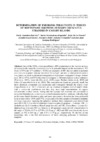Identificador persistente para citar o vincular este elemento:
https://accedacris.ulpgc.es/jspui/handle/10553/121961
| Título: | Determination of emerging pollutants in tissues of bottlenose dolphins (Tursiops Truncatus) stranded in Canary islands | Autores/as: | González-Bareiro, Emily Montesdeoca Esponda, Sarah De la Fuente, Jesús Sosa Ferrera, María Zoraida Arbelo Hernández, Manuel Antonio Fernández Rodríguez, Antonio Jesús Santana Rodríguez, José Juan |
Clasificación UNESCO: | 330811 Control de la contaminación del agua 240119 Zoología marina 220922 Radiación ultravioleta |
Palabras clave: | UV filters UV stabilizers Bottlenose Dolphin Blubber MAE, et al. |
Fecha de publicación: | 2023 | Editor/a: | Servicio de Publicaciones y Difusión Científica de la Universidad de Las Palmas de Gran Canaria (ULPGC) | Conferencia: | VIII International Symposium on Marine Sciences (ISMS 2022) | Resumen: | Around the 1900s, emerging pollutants (EPs) contamination has become an issue of interest to the scientific community due to its potential impact on the environment. UV filters (UVFs) and UV stabilizers (UVSs) are examples of EPs that are added to personal care products to protect skin and hair from the sunlight, and also to other products such as wax, plastic or textile to inhibit photodegradation of polymers and pigments (Gago- Ferrero et al., 2013). UVSs and UVSs have been investigated in different matrices such as sediments (Tsui et al., 2015), water (da Silva et al., 2015), algae (Pacheco-Juárez et al., 2019) and fishes (Gimeno-Monforte et al., 2020). The concentrations found are generally small, but these chemicals compounds can accumulate and biomagnify through the trophic chain (Gago-Ferrero et al., 2012). Cetaceans are top predators at highest level of trophic chain, with a worldwide distribution and they may have high concentrations of organic contaminants in their tissues. Taking into the account that cetaceans are considered as ecosystem bioindicators, a microwave assisted extraction method combined with ultra-high performance liquid chromatography and mass spectrometry detection has been performed to determine twelve UVFs and UVSs compounds in blubber samples of bottlenose dolphins (Tursiops truncatus). Applying the optimized method, three compounds were detected and quantified: BP-3 (1-(4-tert-butylphenyl)-3-(methoxyphenyl) propane- 1,3-dione), IMC (3- methylbutyl (E)-3-(4-methoxyphenyl) prop-2enoate) and OC (2-ethylhexyl 2-cyano-3,3- diphenylprop-2-enoate). OC was detected in all specimens analyzed with concentrations in the range of 52.61± 18.59 to 107.99 ± 11.32 ng g-1. BP3 and IMC were found only in one sample, at 5.92 ± 0.04 ng g-1 and 8.55 ± 1.19 ng g-1, respectively. To the best of our knowledge, this is the first determination of these emerging pollutants in bottlenose dolphins. | URI: | https://accedacris.ulpgc.es/handle/10553/121961 | ISBN: | 978-84-9042-477-3 | Fuente: | Abstracts Volume VIII International Symposium on Marine Sciences, July 2022 / coordinación, María Esther Torres Padrón, p. 109-110 |
| Colección: | Ponencias |
Visitas
86
actualizado el 29-jun-2024
Descargas
40
actualizado el 29-jun-2024
Google ScholarTM
Verifica
Altmetric
Comparte
Exporta metadatos
Los elementos en ULPGC accedaCRIS están protegidos por derechos de autor con todos los derechos reservados, a menos que se indique lo contrario.
